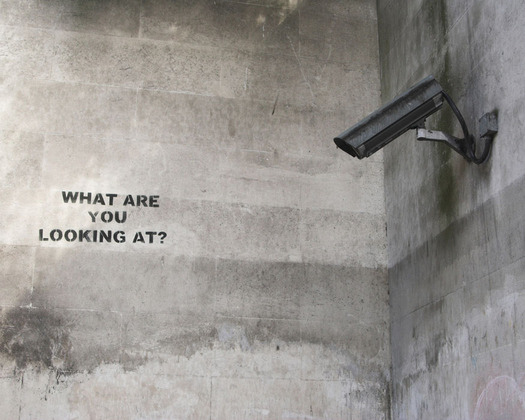Attributed to Banksy. I’m told this is in San Francisco. Via One Eyeland.
Six months ago, running around San Francisco on a reporting trip, I decided to pay conscious attention to security cameras. There was no specific reason for this. I just like to give myself a “looking assignment” sometimes, usually focusing on some prevalent and recurring but easily overlooked element of the built environment. Just something to do.
Of course it will surprise no one to hear that once you start looking out for security cameras in a large American city, you’ll notice them everywhere. But that wasn’t quite the point, and the exercise did turn out to be instructive, and maybe even productive. I still think about it, and it’s led to a whole strand of sporadic research about how various artists and designers have dealt with this category of object — or could.
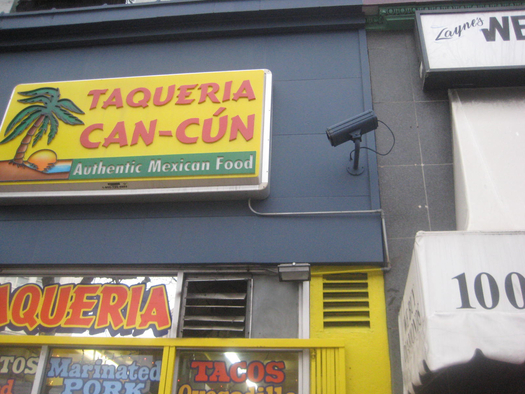
Shy security camera, San Francisco, January 2013
Of most interest to me, as I tromped to various appointments, was a certain confusion or contradiction about whether or not these cameras are things that want to be seen.
Two snapshots sum it up. Most cameras seem to be placed rather discretely, well above eye-level. In this first picture (above), the camera has even been painted the same color as the wall it’s mounted on — camouflaged, almost. Perhaps the thinking is that a noticeable security camera signals a site of potential danger. Or maybe discretion nods to the idea that walking around in full awareness of just how commonplace such cameras have become would freak people out.
Even so, the opposite urge manifested itself with some frequency: Aggressive signs announcing the presence of surveillance devices, with the air of a threat. In the instance below, amusingly, that threat (on a fairly redundant sign) was answered by a graffiti writer actually tagging the thing.
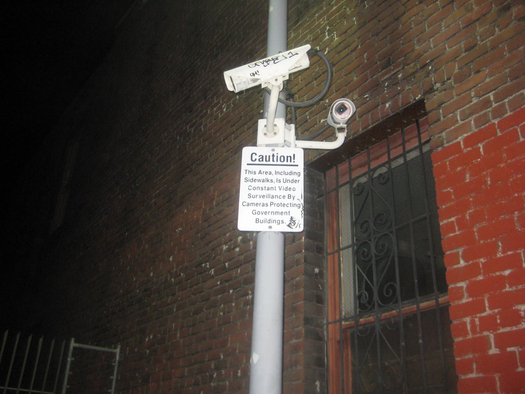
Brash security cameras, San Francisco, January 2013
By the time my assignment had ended, I'd decided cameras should, in fact, want to be seen. As a practical matter, they can’t function as deterrents if they’re overlooked. And if there is going to be a massive system of surveillance equipment all of the place, it should not hide from us. On the other hand, strident signage contributes an air of menace, and even oppression, to city streets.
And so I began to speculate: What if one were to recruit a bunch of artists and designers, match them up with businesses and other entities in a particular city, and visually beautify as many security cameras as possible? I was thinking about something modeled on the irritating “CowParade” fad, but in this case transforming security cameras (instead of bovine statuary) into decorative, aesthetically pleasing objects — vehicles for art that brightens the urban scene.
Just think of the visual possibilities here. Chipper polka dots. Snappy checkerboard. Screaming day-glo paisley. The paradoxical possibilities with camo patterns are endless, but imagine a dazzle-style security camera! And that's without even thinking of specific artists and designers. I'd certainly like to see what Shepard Fairey might do with a security camera as medium. (Would the result end up a potential target of theft? This sparks another line of thought: security cameras wrapped in razor wire, perhaps.)
Sadly my imagination seems to have gotten ahead of me this time; there was no interest. Oh well. I moved on to other matters.
But meanwhile, a few things have happened that cause me to bring all of this up here. First: Through research, conversation, and simple heightened awareness of the subject, I have learned about quite a number of art/design responses to surveillance systems, and a smaller number focused squarely on the security camera itself, as an object.
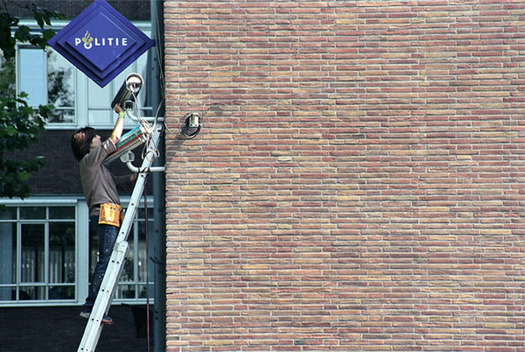
From “System Azure / Rhinestoning Headquarters,” by Jill Magid.

From “System Azure / Rhinestoning Headquarters,” by Jill Magid.
I’ll note two here. Jill Magid’s “System Azure / Rhinestoning Headquarters” project, dating back to 2003, involved hand-gluing rhinestones to security cameras in Amsterdam (notably one attached to local police headquarters), converting them into eye-catching “glam cams.”
And just last month: The artist duo FRONT404 dressed up a bunch of security cameras around Utrecht, the Netherlands, with party hats, to mark the birthday of George Orwell. “By making these inconspicuous cameras that we ignore in our daily lives catch the eye again,” they wrote, “we also create awareness of how many cameras really watch us nowadays.”
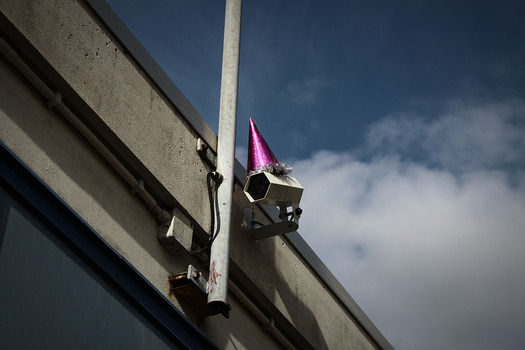
From “George Orwell’s Birthday Party,” by FRONT 404
Meanwhile, there's the other thing that has happened since my conjectural daydream: the Boston Marathon bombing.
Footage gathered by surveillance cameras was reportedly crucial to identifying the suspects, and at least some observers reacted with full-throated calls for more surveillance equipment in the public realm. Then again, widespread use of security cameras clearly did not prevent the bombing, and other observers countered that more security cameras won’t help — and have indeed never been all that effective as a way of curtailing criminal activity.
All of which suggests to me that the security camera is an everyday city object that deserves to be looked at, even more so than when I started idly musing about it early this year. I like the projects cited above, as well as many others I don’t have room for here, but what I really hope such efforts do is inspire even more creative attempts to focus broader attention on, and discussion of, widespread surveillance systems.
Perhaps St. Louis would be a good venue for such projects. After the Boston bombings, officials there pointed to the role of security camera footage in identifying the suspects as evidence in favor of building out the official surveillance infrastructure in that city. But let’s remember that we’re not simply talking about state surveillance: Cameras belonging to retailers, but partly trained on sidewalks and other public space, were reportedly key to the Boston investigation. (For that matter, at least two of my neighbors have security cameras.)
So this is an object that deserves as much scrutiny as it gives. It seens unlikely I’ll ever make my dream project out of this (although, hey, if you have a good partner for me, get in touch!), but I hope my speculation helps make an argument about this near-ubiquitous feature of city life. Basically: Let’s keep an eye on these things.
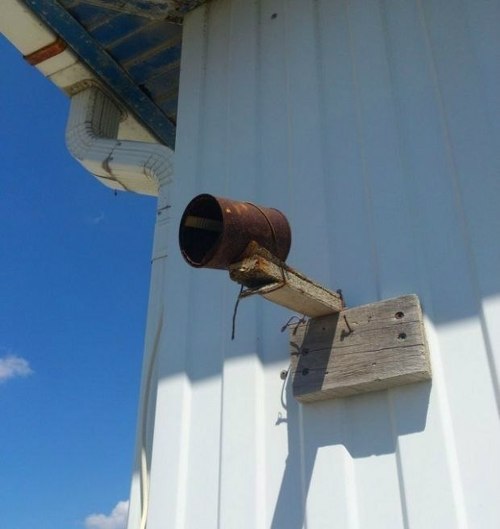
I wish I could tell you more about this, but it’s just something I encountered on Tumblr, with no verifiable information attached.

